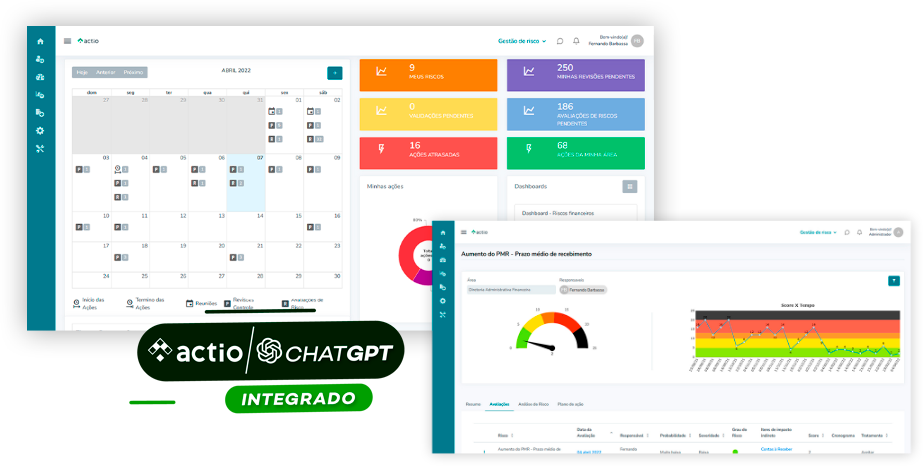Hospital risk management encompasses a set of strategies and measures aimed at preventing dangerous situations and failures that can lead to serious consequences, even putting lives at risk. In healthcare institutions, where every decision can have a profound impact, this approach becomes not only relevant but fundamental.
But do you know what hospital risk management exactly entails, how to implement it, and what advantages it brings? Keep reading to find out!
What you will find on this blog:
ToggleWhat is hospital risk management?

The purpose of risk management is to create and protect value, improve performance, encourage innovation, and achieve objectives. In other words, this approach not only enables superior patient care outcomes but also contributes to a safer and more reliable environment..
By optimizing crisis management, reducing costs, and minimizing threats to patient safety, risk management plays a pivotal role in identifying and assessing risks and adverse events, acting as a protective barrier for both patient’s and healthcare institutions’ reputations.
However, it’s important to note that risk management isn’t limited to dealing with past issues alone—it also embraces a proactive perspective towards the future. By establishing itself as a fundamental practice, risk management ensures the well-being of both patients and healthcare professionals.
Introducing Belt: Risk Management Software
What are the advantages of hospital risk management?
Adopting effective Hospital Risk Management offers a range of significant advantages, positively impacting various aspects of the hospital environment and overall institution performance. Check out the advantages below:
Improved hospital environment
Prioritizing patient, staff, and medical process safety creates a safer and more reliable hospital environment. This leads to more confident and satisfied employees, reducing stress in their daily tasks. This atmosphere fosters a motivated team and positively impacts patient experiences.
Medical service quality
Hospitals investing in the health and well-being of both their staff and patients establish a cycle of mutual benefit. Employees with access to attentive medical services tend to work more diligently. Promoting safety in the hospital environment contributes to better medical performance, resulting in higher service quality, which in turn leads to more positive patient assessments.
Institutional credibility
Hospital Risk Management not only benefits patients and staff but also enhances the hospital’s image. Implementing safety practices, preventing medical errors, and utilizing advanced technologies boost the hospital’s credibility, building trust with patients, families, and the community at large.
2- Reduction of Incident Costs
Promoting safety practices, appropriate training, and stringent protocols reduce adverse incidents in the hospital environment. Consequently, this leads to reduced expenditures related to additional treatments, corrective procedures, and legal actions. Decreasing readmission rates also contribute to more efficient resource management.
Implementing hospital risk management

Effectively implementing risk management requires well-defined steps, establishing a solid foundation for professionals, and ensuring the institution remains oriented and avoids potential losses. types of risks faced by hospitals:
1- Risk identification
The starting point is identifying potential risks faced by the healthcare institution. A team of healthcare professionals assigned to this task should thoroughly document these assessments for a comprehensive understanding of the scenario. Techniques such as interviews, analysis of previous years’ documents, and team brainstorming sessions can aid in risk determination.
2- Risk analysis
Once risks are identified and recorded, it’s crucial to assess which risks could have significant impacts on operations and which ones have potential minor consequences.
Each risk can be analyzed qualitatively and quantitatively. Qualitative analysis evaluates each risk based on the probability of occurrence, ranging from “very high” to “very low.”
Quantitative analysis employs numerical data to assess potential risks.
3- Risk assessment
It’s essential to evaluate which risks need to be prioritized for treatment, considering their potential impact on healthcare institutions.
These risks move on to the next stage: risk treatment. Tools like HACCP (Hazard Analysis and Critical Control Points) can assist in this assessment process.
4- Risk treatment
During the risk treatment stage, measures are planned to manage these risks. One example is formulating preventive measures to mitigate the occurrence of adverse events.
Identifying operational areas requiring special attention and identifying necessary changes in healthcare management processes are essential steps for efficient hospital risk management.
5- Risk monitoring
After implementing risk treatment measures, monitoring progress becomes crucial. This monitoring ensures the effectiveness of healthcare risk management.
It’s important to verify the execution of planned measures; assess whether there’s increased efficiency in processes after changes; and identify new risks that may require treatment.
Leveraging technology in risk management

Intelligent use of technology, such as software platforms, can automate many steps in the risk management process, making risk collection, analysis, and monitoring more efficient and proactive. This aids communication, action tracking, and risk information visualization, enhancing decision-making.
Example from Oswaldo Cruz Hospital:
Paulo Ferreira, the internal audit manager at Oswaldo Cruz Hospital, has dealt closely with a series of challenges since entering this complex world. In an exclusive event held by Actio,he shared his insights about the challenges posed by hospital management and how innovation and intelligent technology use can help overcome them.
One of Ferreira’s major challenges was starting the hospital’s internal audit from scratch. He highlights that, in the past, all hospital processes were manually done, with Excel spreadsheets used to track deadlines and progress on recommendations. With the adoption of the Actio platform, these steps became more automated, making action tracking and communication with managers easier. “This platform introduced a new dynamic and made our work easier”,comments Ferreira.
In addition to the challenges of internal auditing, Paulo was also involved in another crucial task: introducing risk management at the hospital. Working alongside experienced colleagues, they created a system to identify and control risks. The introduction of Actio’s technology, especially with the Beltrisk management module, was a significant advancement. “Now, managers can directly access information about risks, actions, and solutions“,, he explains.
Paulo Ferreira’s successful journey at Oswaldo Cruz Hospital demonstrates how innovation and intelligent technology use can help overcome complex challenges.By improving internal audit processes and risk management, Ferreira and his team have shown the ability to adapt and thrive even in difficult circumstances.
Introducing Belt: risk management software

The best way to avoid unpleasant surprises is to manage risks. With Belt, you can do so more efficiently! Belt is risk management software that systematizes risk management for your hospital. With it, you can apply industry-best management practices to ensure your organization remains unaffected by negative scenarios.
With a variety of comprehensive features, the software provides complete control over hospital management. This includes integrating risk administration, conducting risk mapping, classification, and treatment, and aligning with ISO 31.000, COSO, and PMI certifications. Belt also facilitates the development of action plans and mitigation strategies, and much more. Those who use it, recommend it!
Like the content? Don’t forget to follow Actio on Instagram, Linkedin and Facebook.






